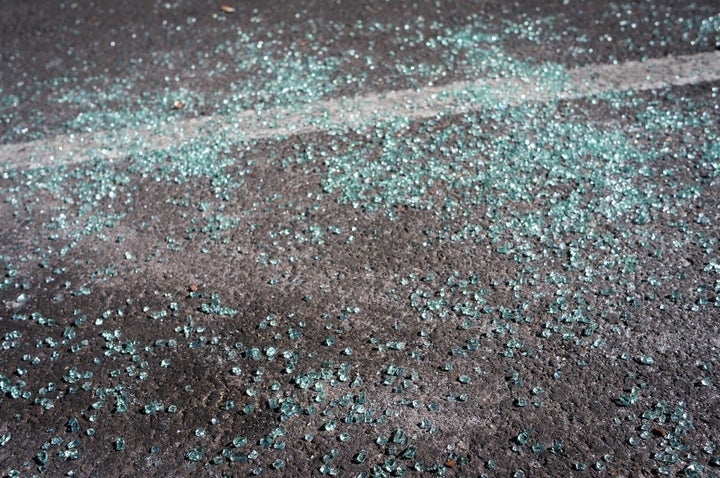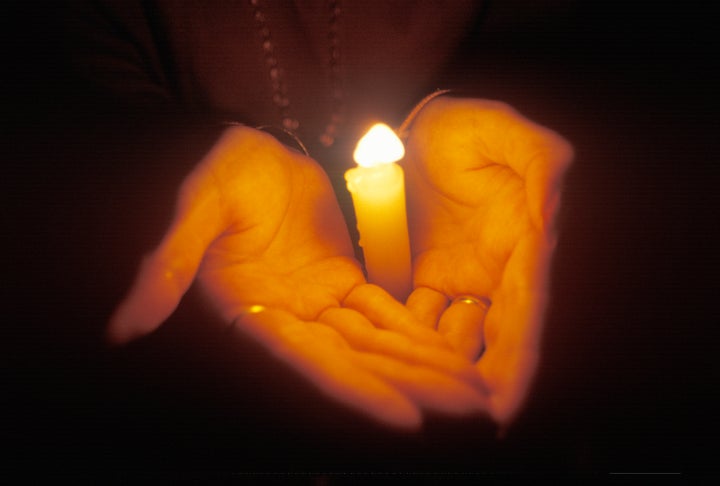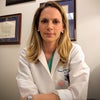
Joanna was on her way to work one bright Thursday morning. For reasons that will forever remain unknown, she veered across the wide median of a large divided highway at high speed, and crashed head first into oncoming traffic. She was 26 years old, an only child.
I was heading to work while chatting with my sister via car speakerphone. We were laughing about… something, about nothing, as I approached a long straight stretch of the interstate highway.
Suddenly, there was a significant departure from the monotony of cars moving steadily within white dotted lanes on blacktop. A small mangled black car was sitting sideways in the middle of the large grassy median, a demolished pickup truck was pulled over on the opposite side of the road, and there was wreckage from an obvious crash.
The first few cars had just started to slow down, but there was no real traffic yet. The accident was fresh, just seconds ahead of my own travels.
My words trailed off and my sister’s voice became a distant muted sound. It had been several years since I’d been in the trauma bay as a general surgery resident, although there are some protocols that are deeply ingrained during training; drills that surgeons do not forget. Part of that muscle memory is to start moving toward the injured as quickly as possible.
My pulse began to rise, my mouth went dry. I told my sister I had to go.
“Inside the black car, a young woman was slumped to the side into the passenger seat, unconscious. All airbags had deployed, with broken glass all around.”
Pulling into the median just ahead of the crash, I got out and ran towards the black car, feeling hyperaware of my surroundings due to the adrenaline beginning to enter my bloodstream. There was debris everywhere. Pieces of a fender, a headlight, clothes, a laundry basket; the trunk of the black car had popped open, items strewn around haphazardly.
I glanced at a lone car engine, lying in the grass, smoke emanating from its twisted pipes and fans. It looked so peculiar, so wrong, uncoupled from its housing within the hood of a car. The image of that solitary engine in the un-mowed grass would be permanently seared into a dark core memory.
Angry shouts were coming from the pickup truck on the other side of the highway. My mind raced. He’s okay for now. Keep running.
Inside the black car, a young woman was slumped to the side into the passenger seat, unconscious. All airbags had deployed, with broken glass all around. The front of the car was completely destroyed. I reached in through the broken passenger door window and pressed my fingers against her neck – I could feel a carotid pulse. But she was not breathing, not moving.

Another man had pulled over, and as he was getting out of his car, I shouted for him to call 911. I tried to open the passenger door handle, but it was crushed in and wouldn’t budge. I ran to the driver’s side. Two others had stopped, and opened both driver’s side and the back seat door. Now there were more people coming, slowly converging on the car with visible panic and fear, but wanting to help.
I leaned in across her body and felt again for her carotid pulse; this time, it wasn’t as strong. Quickly scanning the inside of the car, there was smoke coming from the dashboard vents and I momentarily thought about an explosion – but I distinctly thought that seemed unlikely, given that the car engine was lying in the grass 20 feet away.
I looked down at her face. She looked so young. What on earth had just happened?
I pulled my hair into a frantic ponytail. A quick assessment revealed a fractured arm and mild facial abrasions, but otherwise no obvious external injuries. Several men and women helped to gently and slowly remove her from the car, including a trauma nurse and an emergency medical technician who also happened to stop. By this time there were 20 or 30 people gathered around the car. Someone passed around gloves.
Once she was safely on the grass, breathing became the greatest concern. If her heart was beating, but she wasn’t getting any oxygen, her heart would stop ― soon. Shouts all around for a mask were fruitless, and her lips and face were becoming a dusky blue.
Someone found a plastic raincoat. I ripped a hole in it and placed it on her face, and tried to administer a breath. Unsuccessful, too much blood. I had no tools to perform an emergency airway procedure called a cricothyroidotomy, similar to a tracheostomy, used in times of absolute necessity to gain immediate access to someone’s airway.
We were stuck. I heard myself cursing.
Within seconds, she lost her pulse. We immediately started CPR. The trauma nurse, the emergency medical tech, and I rotated performing firm deep compressions to the center of her chest in an attempt to restart her heart. Firemen and State Troopers arrived. They had some emergency equipment, and began manually pushing air into her lungs with a bag-valve mask. We continued CPR, but she still had no pulse.
The sun was hot on our backs, with no wind, and beads of sweat turned into drips down our foreheads and temples. Chest compressions, when done properly, are exhausting to perform. The insides of my too-large gloves were damp with sweat, and strands of hair kept falling in my face and sticking to my forehead.
“I got into my car, called my husband… and burst into tears. For the next two days, I had no idea what became of [Joanna].”
I noticed how strangely quiet it was and looked up; there was no sound of traffic, because not a single car had driven by us on either side of the highway. All cars had been stopped for miles in both directions.
Finally, the sound of a siren emerged, and an ambulance arrived on the scene, with life-saving equipment and medicine. Emergency medical technicians placed an intraosseous line into her leg – like an intravenous line, but instead of going into a vein, the fluids and medicine are administered into the bone marrow, where they are rapidly absorbed. Two sticky pads were placed on her chest, attached to the monitor, and it was utterly silent as we knelt on the grass beside her and anxiously waited for the screen to display any cardiac activity.
There was none. Flatline, asystole. No shock was delivered.
We restarted CPR, and she received an ampule of adrenaline into her bone marrow. A breathing tube was placed by an EMT, connected to a canister of fresh oxygen now being delivered to her lungs. Another round of adrenaline. More CPR. Flatline on the monitor.
And then… her heart began beating again. All eyes were on the tiny electrical signal bouncing down the screen. There it was, 105 beats per minute, with a palpable carotid pulse. We looked up at each other; our faces, flushed and sweaty, flickered with joy, relief, anguish. We experienced a collective moment of rare and unparalleled humanity: the return of life.
Her pulse was steady for the next five minutes, long enough for transportation onto a stretcher. LifeStar medical helicopter had arrived and landed in the middle of the highway. Still unconscious and requiring ventilation with the breathing tube, she was loaded into the helicopter, and within seconds, they took off into the early morning sunshine.
After giving a statement to the State Trooper, I walked back to my car, dazed. The intense and hectic moment was over, but my head was still spinning. A full schedule of surgeries and patients awaited me at work, and I knew I had to collect myself. I got into my car, called my husband… and burst into tears.
For the next two days, I had no idea what became of her. I was full of fear, worried about her injuries and likely outcome. A traumatic cardiac arrest generally indicates significant internal injuries, and the chances of full recovery are slim. I knew she could die. Yet, I was also hopeful because of my ignorance about her condition.
“Doctors are often the attendants of death ... and although the outcome is always the same, each death is as unique as the life it ends.”
I am no stranger to death. Including four years of medical school, the subsequent eight years of general surgery residency and fellowship, and now as an oncology surgeon, I have experienced it many times. Doctors are often the attendants of death, and it has been a part of my chosen profession since I started this journey. And although the outcome is always the same, each death is as unique as the life it ends.
Being a doctor means dealing with suffering and anguish, both as a physician and simply as a human being. During my surgical training, I witnessed pain and loss through the eyes of strangers. Consoling families, explaining the treatments and medicines that ultimately failed, and witnessing their agony is a duty and privilege bestowed upon physicians. It is part of an internal calling for doctors, and one of the most difficult.
Yet in order to survive the distress of these experiences and continue to practice medicine, physicians must find ways of somehow managing their feelings when their patients die. Different doctors have different coping mechanisms, sometimes utilizing emotional suppression and a capacity for brute force mental redirection – these were tools I’d certainly refined as part of my physician exterior.
However, the death of a young parent, teenager, or child was a direct challenge to the emotional barriers I’d constructed. It became incomprehensible to explain why someone young died, what interventions didn’t work, how this could happen or make any sense. These unforgettable and agonizing moments punctuated my training as I progressed through residency.
There were no adequate answers to explain why a 4-week-old newborn baby died in his parents’ arms, conceding his tiny, quiet fight to a severe abdominal infection that would not yield to antibiotics or surgery.
No sufficient reasons to explain why a 30-year-old mother of three small boys died from metastatic breast cancer, despite all forms of cytotoxic treatments and surgery to remove the malignant cells that eventually consumed her body.
No rational sense was made when a toddler became lifeless from traumatic head injuries, injuries that could only have been from child abuse, while the other victim, his mother, screamed into the silence of the pediatric surgical intensive care unit.
All that was left was piercing heartache and an unnatural, quiet emptiness where life had once been.
But Joanna… she didn’t die, we got her back. We got there in time. She was supposed to live.
I scoured online sources for information about her. Eventually I found the news report that confirmed my fears: she died the afternoon after the crash. I cried all the way home that day.
Joanna’s wake was scheduled for the following week. I anxiously wanted to attend, but was sure the boundaries between bystander and family would be apparent, and worried about a lack of propriety. After all, I was a stranger to her and to her family. Our brief meeting was one sided, and would always be so. Still, I felt an as yet inexplicable urgency to be there, to bear witness to her death with her loved ones. With great trepidation, I made up my mind; I kissed my husband and my three small children goodbye that evening, and drove to the funeral home. I will never regret that decision.
“With a tortured recognition in her eyes, [Joanna's mother] stood and reached out to me. We held each other, mother to mother, and wept for a long time.”
Throngs of visitors crowded the funeral parlor, with more arriving every minute. I recognized Joanna’s father from pictures on social media, a young father with a kind and tired face, and went toward him in the receiving line. As I approached him, I started shaking. I could not control it. I put my trembling hand out, and he warmly took it, looking at me blankly.
“… Are you Kevin?” He nodded. I couldn’t get any words out, and didn’t know what to say. I hadn’t thought that far ahead. My voice quietly crumbled, and I felt myself squeezing his hand tighter and tighter, white-knuckled with uncertainty and pain. “You don’t know me… I … I was there, I was at the accident…” Tears began pooling in my eyes.
His face changed. “Oh my God,” he said, and pulled me toward him. We stood together in a tight embrace and cried. I sobbed into this stranger’s shoulder, and he held me with warm, comforting arms as only a father can. In that moment, I knew he would never hold his own daughter like that again, and it broke my heart.
Kevin brought me over to Joanna’s mother; they knew who I was because the State Trooper had explained the events of that morning. With a tortured recognition in her eyes, she stood and reached out to me. We held each other, mother to mother, and wept for a long time. Her pain was so raw, so absolute, so wretchedly powerful. I prayed I would never understand it, but I felt the crushing weight of it just then.

We didn’t need to say much. I told them I was sorry, so incredibly sorry that I was unable to do more, that I couldn’t save her. I told them I would never forget her, that this experience had changed something in me. I thanked them for welcoming me into their intensely personal anguish with warm, open arms, and allowing me to attend the funeral and share in their grief, when they could have easily turned me away.
They held my hands in theirs and expressed a sincere and deep gratitude that they were able to see her alive, however briefly. They were able to kiss their one and only child, their baby, hold her hand, and tell her that they loved her for the very last time.
Kevin walked me to my car. He explained that Joanna was flown to the hospital, but became very unstable during the flight. She had severe internal injuries which required immediate surgery, but her blood pressure kept dropping. It was then that they discovered she had a devastating high cervical spine dislocation due to rapid deceleration from the accident, one that is not survivable.
Despite arriving to the hospital alive and surviving an operation, her condition began to deteriorate rapidly. She never regained consciousness, and died the next day, surrounded by her loved ones.
Kevin also had immediately worried about the other driver, and had called around to make sure he was alright, which he was. These were kind, good people. They wanted to donate what organs they could, and Joanna was able to become a partial organ donor, her last gift to the world.
“[Joanna's parents] provided me with something I had not known I needed: closure not only for Joanna’s death, but for all the losses I’d experienced over the past 14 years...”
I drive past the site nearly every day. I drive slowly and cautiously, in the far right lane, and think about Joanna. Her death has been unusually poignant for me. During my surgical training, it was not possible to attend the funerals of patients for whom I’d cared. Not only are there limits on time spent outside of the hospital, but decorum and social norms also prohibit this type of personal involvement as a trainee. And while every patient death encountered as a resident may have deeply affected me on a subconscious level, my ability to move past these experiences was both self-protective and vital to my training.
I had built those walls so that I could take care of the next patient. Indeed this was fairly required in order to successfully navigate the emotional road of dealing with life and death as a physician. As a result, I never fully allowed myself to mourn the loss of any individual patient.
Attending Joanna’s funeral and experiencing the intricacy and depth of that pain outside the hospital setting was necessary for me as a doctor, despite the fact that I attended her funeral outside of any clinical duties. Somehow it was as though her death released an accumulation of all of the grief I’d ever experienced as a physician, and I was simply unable to hold it in. After so many years of keeping a stoic face, I just couldn’t do it any longer.
I was inconsolable for a long time after her death. Joanna was just a child, and although not my daughter, she represented all the young patients I’d lost. From that life-changing moment when I pulled my car over to the side of the highway, she became much more than an injured patient on the side of the road.
She became the face of all of the pain I had buried, and the terrible unfairness of death. Her family became the parents, siblings, and grandparents of the lost patients whom I had subconsciously tried to forget over the years.
Because of their generosity, Sandy and Kevin provided me with something I had not known I needed: closure not only for Joanna’s death, but for all the losses I’d experienced over the past 14 years. I will be forever indebted to them for permitting me to share in their excruciating sorrow with so much grace and kindness, to remember, and to say goodbye.
Rest in peace, Joanna.
***This essay was published with the express written consent of Sandy and Kevin, with my sincerest appreciation.***
